The Best Nasa Space House in the Usa
 | |
| Clockwise from the top: Vehicle Assembly Building, Shuttle Landing Facility, Launch Control Center, Visitor Complex, KSC Headquarters Building and Crew Dragon Endeavour on Pad 39A | |
 KSC shown in white; CCSFS in greenish | |
| Abbreviation | KSC |
|---|---|
| Named subsequently | John F. Kennedy |
| Germination | July 1, 1962 (1962-07-01) |
| Type | NASA facility |
| Location |
|
| Coordinates | 28°31′27″Due north lxxx°39′03″W / 28.52417°N fourscore.65083°W / 28.52417; -80.65083 Coordinates: 28°31′27″North 80°39′03″W / 28.52417°Due north fourscore.65083°W / 28.52417; -80.65083 |
| Official language | English |
| Possessor | NASA |
| Director | Janet Due east. Petro[1] |
| Budget | Us$2,218 one thousand thousand[ii] (2021) |
| Staff | x,733[2] [note 1] (2021) |
| Website | www |
| Formerly called | Launch Operations Center |
| [3] | |
The John F. Kennedy Space Center (KSC, originally known equally the NASA Launch Operations Center), located on Merritt Isle, Florida, is one of the National Aeronautics and Space Administration's (NASA) ten field centers. Since December 1968, KSC has been NASA's chief launch center of man spaceflight. Launch operations for the Apollo, Skylab and Space Shuttle programs were carried out from Kennedy Space Center Launch Circuitous 39 and managed by KSC.[4] Located on the east coast of Florida, KSC is side by side to Cape Canaveral Infinite Strength Station (CCSFS). The management of the two entities work very closely together, share resources and operate facilities on each other's holding.
Though the first Apollo flights and all Project Mercury and Project Gemini flights took off from the then-Cape Canaveral Air Force Station, the launches were managed by KSC and its previous organization, the Launch Operations Directorate.[v] [vi] Starting with the fourth Gemini mission, the NASA launch control center in Florida (Mercury Control Center, later the Launch Command Center) began handing off control of the vehicle to the Mission Control Center in Houston, soon after liftoff; in prior missions it held control throughout the entire mission.[7] [8]
Additionally, the center manages launch of robotic and commercial crew missions and researches food product and In-Situ Resource Utilization for off-Earth exploration.[ix] Since 2010, the center has worked to become a multi-user spaceport through manufacture partnerships,[10] even calculation a new launch pad (LC-39C) in 2015.
There are well-nigh 700 facilities and buildings grouped across the centre's 144,000 acres (580 km2).[eleven] Among the unique facilities at KSC are the 525-pes (160 m) tall Vehicle Assembly Building for stacking NASA's largest rockets, the Launch Control Center, which conducts infinite launches at KSC, the Operations and Checkout Building, which houses the astronauts dormitories and suit-upwards area, a Space Station factory, and a 3-mile (four.eight km) long Shuttle Landing Facility. At that place is also a Company Circuitous open to the public on site.
Formation [edit]
The war machine had been performing launch operations since 1949 at what would become Cape Canaveral Space Force Station. In December 1959, the Section of Defense force transferred 5,000 personnel and the Missile Firing Laboratory to NASA to become the Launch Operations Directorate nether NASA's Marshall Space Flying Centre.[12]
President John F. Kennedy's 1961 goal of a crewed lunar landing by 1970 required an expansion of launch operations. On July 1, 1962, the Launch Operations Directorate was separated from MSFC to get the Launch Operations Center (LOC). Likewise, Cape Canaveral was inadequate to host the new launch facility design required for the mammoth 363-foot (111 m) tall, 7,500,000-pound-force (33,000 kN) thrust Saturn V rocket, which would be assembled vertically in a big hangar and transported on a mobile platform to i of several launch pads. Therefore, the decision was fabricated to build a new LOC site located adjacent to Cape Canaveral on Merritt Island.[13]
NASA began land conquering in 1962, buying title to 131 square miles (340 kmtwo) and negotiating with the state of Florida for an boosted 87 square miles (230 kmii).[14] The major buildings in KSC's Industrial Area were designed past builder Charles Luckman.[15] Structure began in November 1962, and Kennedy visited the site twice in 1962, and again just a week before his assassination on Nov 22, 1963.[16]
On November 29, 1963, the facility was given its current proper name past President Lyndon B. Johnson nether Executive Order 11129.[17] [18] Johnson'south society joined both the civilian LOC and the military machine Cape Canaveral station ("the facilities of Station No. 1 of the Atlantic Missile Range") under the designation "John F. Kennedy Space Centre", spawning some confusion joining the two in the public mind. NASA Ambassador James E. Webb antiseptic this by issuing a directive stating the Kennedy Space Center proper noun applied only to the LOC, while the Air Force issued a full general gild renaming the war machine launch site Cape Kennedy Air Force Station.[19]
Location [edit]
Located on Merritt Island, Florida, the heart is due north-northwest of Cape Canaveral on the Atlantic Bounding main, midway between Miami and Jacksonville on Florida's Space Declension, eastward of Orlando. It is 34 miles (55 km) long and roughly six miles (9.seven km) wide, covering 219 square miles (570 km2). KSC is a major central Florida tourist destination and is approximately one hour's drive from the Orlando area. The Kennedy Infinite Center Visitor Complex offers public tours of the centre and Cape Canaveral Space Force Station.[twenty]
Because much of the installation is a restricted area and but nine percent of the state is developed, the site also serves as an important wildlife sanctuary; Mosquito Lagoon, Indian River, Merritt Island National Wildlife Refuge and Canaveral National Seashore are other features of the area. Eye workers can encounter bald eagles, American alligators, wild boars, eastern diamondback rattlesnakes, the endangered Florida panther[ citation needed ] and Florida manatees.
Historical programs [edit]
Apollo plan [edit]

From 1967 through 1973, in that location were thirteen Saturn V launches, including the ten remaining Apollo missions subsequently Apollo 7. The first of two uncrewed flights, Apollo 4 (Apollo-Saturn 501) on Nov nine, 1967, was also the kickoff rocket launch from KSC. The Saturn V's first crewed launch on December 21, 1968, was Apollo 8's lunar orbiting mission. The next two missions tested the Lunar Module: Apollo 9 (Globe orbit) and Apollo 10 (lunar orbit). Apollo xi, launched from Pad A on July 16, 1969, fabricated the beginning Moon landing on July xx. The Apollo eleven launch included crewmembers Neil Armstrong, Michael Collins, and Buzz Aldrin, and attracted a record-breaking 650 million television viewers.[21] Apollo 12 followed 4 months afterwards. From 1970 to 1972, the Apollo plan concluded at KSC with the launches of missions 13 through 17.
Skylab [edit]
On May fourteen, 1973, the last Saturn V launch put the Skylab space station in orbit from Pad 39A. Past this time, the Cape Kennedy pads 34 and 37 used for the Saturn IB were decommissioned, so Pad 39B was modified to accommodate the Saturn IB, and used to launch 3 crewed missions to Skylab that year, as well equally the last Apollo spacecraft for the Apollo–Soyuz Test Project in 1975.
Space Shuttle [edit]

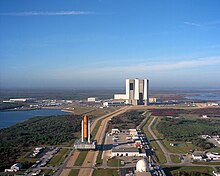
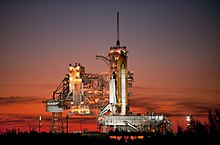
The Space Shuttle Atlantis (STS-129) is seen on launch pad 39A at the NASA Kennedy Space Center shortly after the rotating service construction was rolled dorsum on November fifteen, 2009.
As the Infinite Shuttle was being designed, NASA received proposals for building alternative launch-and-landing sites at locations other than KSC, which demanded report. KSC had of import advantages, including its existing facilities; location on the Intracoastal Waterway; and its southern latitude, which gives a velocity reward to missions launched in easterly most-equatorial orbits. Disadvantages included: its disability to safely launch military missions into polar orbit, since spent boosters would be likely to fall on the Carolinas or Cuba; corrosion from the salt air; and frequent cloudy or stormy weather condition. Although building a new site at White Sands Missile Range in New Mexico was seriously considered, NASA appear its decision in April 1972 to employ KSC for the shuttle.[22] Since the Shuttle could not be landed automatically or by remote control, the launch of Columbia on Apr 12, 1981 for its first orbital mission STS-ane, was NASA's kickoff crewed launch of a vehicle that had not been tested in prior uncrewed launches.
In 1976, the VAB'due south due south parking area was the site of Third Century America, a science and technology display commemorating the U.S. Bicentennial. Concurrent with this event, the U.S. flag was painted on the south side of the VAB. During the tardily 1970s, LC-39 was reconfigured to back up the Space Shuttle. 2 Orbiter Processing Facilities were congenital nearly the VAB as hangars with a third added in the 1980s.
KSC'due south 2.9-mile (4.7 km) Shuttle Landing Facility (SLF) was the orbiters' primary end-of-mission landing site, although the first KSC landing did non take identify until the tenth flight, when Challenger completed STS-41-B on February xi, 1984; the primary landing site until then was Edwards Air Force Base in California, subsequently used as a backup landing site. The SLF also provided a return-to-launch-site (RTLS) abort selection, which was not utilized. The SLF is among the longest runways in the world.[23]
After 24 successful shuttle flights, Challenger was torn apart 73 seconds after the launch of STS-51-L on Jan 28, 1986; the first shuttle launch from Pad 39B and the first U.Due south. crewed launch failure, killing the vii coiffure members. An O-ring seal in the right booster rocket failed at liftoff, leading to subsequent structural failures. Flights resumed on September 29, 1988, with STS-26 later on modifications to many aspects of the shuttle program.
On February 1, 2003, Columbia and her crew of seven were lost during re-entry over Texas during the STS-107 mission (the 113th shuttle flight); a vehicle breakup triggered by damage sustained during launch from Pad 39A on January sixteen, when a piece of foam insulation from the orbiter'south external fuel tank struck the orbiter'south left-wing. During reentry, the harm created a pigsty allowing hot gases to cook the wing construction. Like the Challenger disaster, the resulting investigation and modifications interrupted shuttle flying operations at KSC for more 2 years until the STS-114 launch on July 26, 2005.
The shuttle programme experienced five main engine shutdowns at LC-39, all inside four seconds before launch; and i Abort to Orbit, STS-51-F on July 29, 1985. Shuttle missions during nearly xxx years of operations included deploying satellites and interplanetary probes, conducting space science and technology experiments, visits to the Russian MIR infinite station, construction and servicing of the International Space Station, deployment and servicing of the Hubble Space Telescope and serving as a space laboratory. The shuttle was retired from service in July 2011 after 135 launches.
Constellation [edit]
On October 28, 2009, the Ares I-X launch from Pad 39B was the first uncrewed launch from KSC since the Skylab workshop in 1973.
Expendable launch vehicles (ELVs) [edit]
Beginning in 1958, NASA and military worked side by side on robotic mission launches (previously referred to as unmanned),[24] cooperating equally they broke ground in the field. In the early 1960s, NASA had as many every bit 2 robotic mission launches a calendar month. The frequent number of flights immune for quick evolution of the vehicles, as engineers gathered data, learned from anomalies and implemented upgrades. In 1963, with the intent of KSC ELV piece of work focusing on the ground support equipment and facilities, a dissever Atlas/Centaur arrangement was formed under NASA'south Lewis Center (now Glenn Research Center (GRC)), taking that responsibility from the Launch Operations Center (aka KSC).[8]
Though almost all robotics missions launched from the Cape Canaveral Space Forcefulness Station (CCSFS), KSC "oversaw the terminal assembly and testing of rockets every bit they arrived at the Cape."[eight] In 1965, KSC's Unmanned Launch Operations directorate became responsible for all NASA uncrewed launch operations, including those at Vandenberg Space Strength Base of operations. From the 1950s to 1978, KSC chose the rocket and payload processing facilities for all robotic missions launching in the U.S., overseeing their near launch processing and checkout. In addition to government missions, KSC performed this service for commercial and foreign missions also, though non-U.S. authorities entities provided reimbursement. NASA too funded Greatcoat Canaveral Space Force Station launch pad maintenance and launch vehicle improvements.
All this changed with the Commercial Space Launch Act of 1984, afterwards which NASA only coordinated its ain and National Oceanic and Atmospheric Administration (NOAA) ELV launches. Companies were able to "operate their ain launch vehicles"[8] and employ NASA'southward launch facilities. Payload processing handled by private firms also started to occur outside of KSC. Reagan's 1988 space policy furthered the movement of this work from KSC to commercial companies.[25] That same year, launch complexes on Greatcoat Canaveral Air Force Force Station started transferring from NASA to Air Strength Space Command management.[8]
In the 1990s, though KSC was not performing the hands-on ELV work, engineers nonetheless maintained an understanding of ELVs and had contracts allowing them insight into the vehicles and then they could provide knowledgeable oversight. KSC too worked on ELV research and analysis and the contractors were able to utilize KSC personnel as a resources for technical issues. KSC, with the payload and launch vehicle industries, developed advances in automation of the ELV launch and footing operations to enable competitiveness of U.S. rockets against the global marketplace.[eight]
In 1998, the Launch Services Program (LSP) formed at KSC, pulling together programs (and personnel) that already existed at KSC, GRC, Goddard Space Flying Center, and more to manage the launch of NASA and NOAA robotic missions. Greatcoat Canaveral Space Strength Station and VAFB are the primary launch sites for LSP missions, though other sites are occasionally used. LSP payloads such as the Mars Science Laboratory take been processed at KSC before being transferred to a launch pad on Cape Canaveral Space Force Station.
Space station processing [edit]
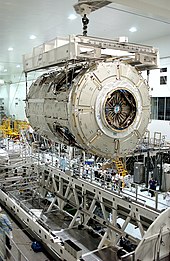
Equally the International Space Station modules design began in the early on 1990s, KSC began to work with other NASA centers and international partners to prepare for processing before launch onboard the Space Shuttles. KSC utilized its hands-on experience processing the 22 Spacelab missions in the Operations and Checkout Edifice to assemble expectations of ISS processing. These experiences were incorporated into the design of the Space Station Processing Facility (SSPF), which began construction in 1991. The Space Station Advisers formed in 1996. KSC personnel were embedded at station module factories for insight into their processes.[8]
From 1997 to 2007, KSC planned and performed on the basis integration tests and checkouts of station modules: three Multi-Element Integration Testing (MEIT) sessions and the Integration Systems Test (IST). Numerous bug were found and corrected that would accept been difficult to nearly incommunicable to practise on-orbit.
Today KSC continues to process ISS payloads from across the world before launch forth with developing its experiments for on orbit.[26] The proposed Lunar Gateway would be manufactured and processed at the Space Station Processing Facility.
Current programs and initiatives [edit]
The following are current programs and initiatives at Kennedy Space Center:[27]
- Commercial Crew Program[28]
- Exploration Ground Systems Program[29]
- NASA is currently designing the next heavy launch vehicle known every bit the Space Launch System (SLS) for continuation of human spaceflight.
- On December 5, 2014, NASA launched the first uncrewed flying examination of the Orion Multi-Purpose Crew Vehicle (MPCV), currently under development to facilitate human exploration of the Moon and Mars.[30] [31]
- Launch Services Program[32]
- Educational Launch of Nanosatellites (ELaNa)[33]
- Enquiry and Technology[9]
- Artemis program
- Lunar Gateway
- International Infinite Station Payloads[26]
- Camp KSC: educational camps for schoolchildren in bound and summer, with a focus on infinite, aviation and robotics.[34]
Facilities [edit]
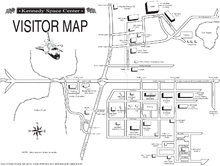
The KSC Industrial Expanse, where many of the center'southward support facilities are located, is five miles (8 km) south of LC-39. It includes the Headquarters Edifice, the Operations and Checkout Building and the Central Instrumentation Facility. The astronaut crew quarters are in the O&C; before it was completed, the astronaut crew quarters were located in Hangar S[35] at the Greatcoat Canaveral Missile Test Annex (now Greatcoat Canaveral Space Strength Station).[sixteen] Located at KSC was the Merritt Island Spaceflight Tracking and Data Network station (MILA), a primal radio communications and spacecraft tracking complex.
Facilities at the Kennedy Infinite Center are directly related to its mission to launch and recover missions. Facilities are available to prepare and maintain spacecraft and payloads for flying.[36] [37] The Headquarters (HQ) Edifice houses offices for the Center Manager, library, film and photo archives, a print shop and security.[38] When the KSC Library first opened, it was part of the Army Ballistic Missile Agency. However, in 1965, the library moved into 3 separate sections in the newly opened NASA headquarters before somewhen becoming a single unit of measurement in 1970.[39] The library contains over 4 million items related to the history and the work at Kennedy. Every bit one of ten NASA center libraries in the land, their drove focuses on engineering science, science, and technology. The athenaeum contain planning documents, film reels, and original photographs covering the history of KSC. The library is not open to the public but is available for KSC, Infinite Force, and Navy employees who work on site.[39] Many of the media items from the collection are digitized and available through NASA's KSC Media Gallery or through their more than upwards-to-engagement Flickr gallery.
A new Headquarters Building was completed in 2022 as part of the Primal Campus consolidation. Groundbreaking began in 2014.[11] [40] [41] [42]
The centre operated its own 17-mile (27 km) brusk-line railroad.[43] This operation was discontinued in 2015, with the sale of its final 2 locomotives. A 3rd had already been donated to a museum. The line was costing $1.three one thousand thousand annually to maintain.[44]
Payload manufacture and processing [edit]

Neil Armstrong Operations and Checkout Building
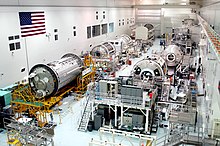
Pre-fabricated ISS modules in the Infinite Station Processing Facility
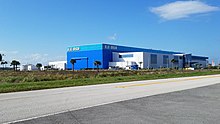
Blue Origin's manufacturing facility nearly KSC company complex
- The Neil Armstrong Operations and Checkout Building (O&C) (previously known as the Manned Spacecraft Operations Edifice) is a celebrated site on the U.S. National Register of Celebrated Places dating back to the 1960s and was used to receive, process, and integrate payloads for the Gemini and Apollo programs, the Skylab programme in the 1970s, and for initial segments of the International Space Station through the 1990s.[45] The Apollo and Space Shuttle astronauts would board the astronaut transfer van to launch complex 39 from the O&C edifice.[46]
- The 3-story, 457,000-square-human foot (42,500 gii) Space Station Processing Facility (SSPF) consists of two enormous processing trophy, an airlock, operational control rooms, laboratories, logistics areas and role infinite for support of not-hazardous Space Station and Shuttle payloads to ISO 14644-1 form five standards.[47] Opened in 1994, it is the largest factory building in the KSC industrial area.
- The Vertical Processing Facility (VPF) features a 71-by-38-foot (22 by 12 m) door where payloads that are processed in the vertical position are brought in and manipulated with ii overhead cranes and a hoist capable of lifting up to 35 short tons (32 t).[48]
- The Hypergolic Maintenance and Checkout Expanse (HMCA) comprises three buildings that are isolated from the residue of the industrial expanse because of the chancy materials handled at that place. Hypergolic-fueled modules that made upwardly the Space Shuttle Orbiter's reaction control organization, orbital maneuvering organisation and auxiliary power units were stored and serviced in the HMCF.[49]
- The Multi-Payload Processing Facility is a 19,647 square feet (one,825.3 m2)[50] building used for Orion spacecraft and payload processing.
- The Payload Chancy Servicing Facility (PHSF) contains a 70-past-110-foot (21 by 34 yard) service bay, with a 100,000-pound (45,000 kg), 85-foot (26 m) hook height. It also contains a 58-by-80-pes (18 by 24 thou) payload airlock. Its temperature is maintained at 70 °F (21 °C).[51]
- The Blue Origin rocket manufacturing facility is located immediately south of the KSC visitor circuitous. Completed in 2019, it serves as the company's manufacturing plant for the manufacture of New Glenn orbital rockets.[52]
Launch Circuitous 39 [edit]
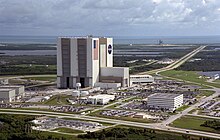
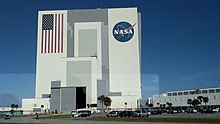
Launch Circuitous 39 (LC-39) was originally congenital for the Saturn V, the largest and most powerful operational launch vehicle in history, for the Apollo crewed Moon landing plan. Since the end of the Apollo program in 1972, LC-39 has been used to launch every NASA human space flight, including Skylab (1973), the Apollo-Soyuz Test Project (1975), and the Space Shuttle program (1981–2011).
Since December 1968, all launch operations have been conducted from launch pads A and B at LC-39. Both pads are on the ocean, 3 miles (4.8 km) eastward of the VAB. From 1969 to 1972, LC-39 was the "Moonport" for all half-dozen Apollo crewed Moon landing missions using the Saturn 5,[53] and was used from 1981 to 2011 for all Space Shuttle launches.
Man missions to the Moon required the large three-stage Saturn Five rocket, which was 363 feet (111 meters) tall and 33 feet (10 meters) in diameter. At KSC, Launch Complex 39 was congenital on Merritt Island to accommodate the new rocket. Construction of the $800 million project began in November 1962. LC-39 pads A and B were completed past Oct 1965 (planned Pads C, D and Due east were canceled), the VAB was completed in June 1965, and the infrastructure by tardily 1966.
The complex includes:
- the Vehicle Associates Building (VAB), a 130,000,000 cubic feet (3,700,000 m3) hangar capable of holding four Saturn Vs. The VAB was the largest structure in the globe past book when completed in 1965.[54]
- a transporter capable of carrying 5,440 tons along a crawlerway to either of two launch pads;
- a 446-foot (136 k) mobile service structure, with 3 Mobile Launcher Platforms, each containing a stock-still launch umbilical belfry;
- the Launch Control Center; and
- a news media facility.
Launch Complex 48 [edit]
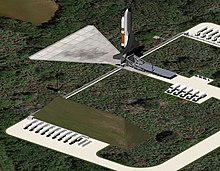
Launch Complex 48 (LC-48) is a multi-user launch site under construction for modest launchers and spacecraft. It volition be located betwixt Launch Complex 39A and Space Launch Complex 41, with LC-39A to the north and SLC-41 to the south.[55] LC-48 will exist constructed as a "clean pad" to support multiple launch systems with differing propellant needs. While initially only planned to have a unmarried pad, the complex is capable of being expanded to 2 at a later on appointment.[56]
Commercial leasing [edit]
Every bit a role of promoting commercial infinite industry growth in the area and the overall centre every bit a multi-user spaceport,[57] [58] KSC leases some of its properties. Here are some major examples:
- Exploration Park to multiple users (partnership with Space Florida)
- Shuttle Landing Facility to Infinite Florida (who contracts use to private companies)
- Orbiter Processing Facility (OPF)-3 to Boeing (for CST-100 Starliner)
- Launch Complex 39A to SpaceX
- O&C High Bay to Lockheed Martin (for Orion processing)
- Land for FPL's Space Coast Next Generation Solar Free energy Middle to Florida Power and Light (FPL)[59] [threescore] [61]
- Hypergolic Maintenance Facility (HMF) to United Paradyne Corporation (UPC)[62]
Visitor complex [edit]

The Kennedy Space Heart Company Complex, operated by Delaware Northward since 1995, has a multifariousness of exhibits, artifacts, displays and attractions on the history and future of human and robotic spaceflight. Bus tours of KSC originate from here. The circuitous likewise includes the separate Apollo/Saturn V Centre, north of the VAB and the U.s. Astronaut Hall of Fame, six miles westward near Titusville. At that place were ane.five million visitors in 2009. It had some 700 employees.[63]
It was appear on May 29, 2015, that the Astronaut Hall of Fame showroom would be moved from its current location to another location inside the Visitor Complex to make room for an upcoming high-tech allure entitled "Heroes and Legends". The attraction, designed by Orlando-based design firm Falcon's Treehouse, opened Nov 11, 2016.[64]
In March 2016, the visitor heart unveiled the new location of the iconic countdown clock at the circuitous'southward entrance; previously, the clock was located with a flagpole at the press site. The clock was originally congenital and installed in 1969 and listed with the flagpole in the National Register of Historic Places in January 2000.[65] In 2019, NASA historic the 50th anniversary of the Apollo program, and the launch of Apollo 10 on May eighteen.[66] In summer of 2019, Lunar Module 9 (LM-9) was relocated to the Apollo/Saturn V Center as part of an initiative to rededicate the center and celebrate the 50th anniversary of the Apollo Program.
Celebrated locations [edit]
NASA lists the following Historic Districts at KSC; each district has multiple associated facilities:[67] [68] [69]
- Launch Complex 39: Pad A Historic District
- Launch Complex 39: Pad B Historic District
- Shuttle Landing Facility (SLF) Area Historic Commune
- Orbiter Processing Celebrated District
- Solid Rocket Booster (SRB) Disassembly and Refurbishment Complex Historic District
- NASA KSC Railroad System Historic District
- NASA-owned Cape Canaveral Space Force Station Industrial Area Celebrated District
In that location are 24 historic backdrop exterior of these historic districts, including the Space Shuttle Atlantis, Vehicle Assembly Building, Crawlerway, and Operations and Checkout Building.[67] KSC has i National Historic Landmark, 78 National Annals of Celebrated Places (NRHP) listed or eligible sites, and 100 Archaeological Sites.[70]
Other facilities [edit]
- The Rotation, Processing and Surge Facility (RPSF) is responsible for the grooming of solid rocket booster segments for transportation to the Vehicle Associates Edifice (VAB). The RPSF was built in 1984 to perform SRB operations that had previously been conducted in loftier bays ii and four of the VAB at the beginning of the Space Shuttle program. Information technology was used until the Infinite Shuttle's retirement, and will exist used in the future by the Space Launch System[71] (SLS) and OmegA rockets.
Weather [edit]
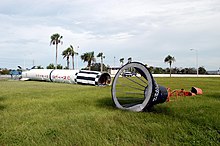
A Mercury Redstone rocket on display at Gate 3 was toppled by Hurricane Frances on September 7, 2004.
Florida'southward peninsular shape and temperature contrasts between land and ocean provide ideal weather for electrical storms, earning Central Florida the reputation as "lightning capital letter of the United States".[72] [73] This makes extensive lightning protection and detection systems necessary to protect employees, structures and spacecraft on launch pads.[74] On November fourteen, 1969, Apollo 12 was struck by lightning simply after lift-off from Pad 39A, merely the flight continued safely. The most powerful lightning strike recorded at KSC occurred at LC-39B on August 25, 2006, while shuttle Atlantis was being prepared for STS-115. NASA managers were initially concerned that the lightning strike caused damage to Atlantis, just none was found.[75]
On September 7, 2004, Hurricane Frances directly hitting the surface area with sustained winds of 70 miles per hr (110 km/h) and gusts up to 94 miles per hour (151 km/h), the virtually damaging storm to appointment. The Vehicle Assembly Building lost one,000 exterior panels, each iii.9 anxiety (1.2 m) ten 9.8 feet (3.0 m) in size. This exposed 39,800 sq ft (3,700 thouii) of the edifice to the elements. Damage occurred to the southward and east sides of the VAB. The shuttle's Thermal Protection System Facility suffered extensive damage. The roof was partially torn off and the interior suffered water damage. Several rockets on display in the center were toppled.[76] Further damage to KSC was acquired by Hurricane Wilma in October 2005.
The conservative estimate by NASA is that the Space Eye will experience five to 8 inches of sea level ascent past the 2050s. Launch Complex 39A, the site of the Apollo 11 launch, is the most vulnerable to flooding, and has a 14% annual risk of flooding beginning in 2020.[77] [78]
KSC directors [edit]
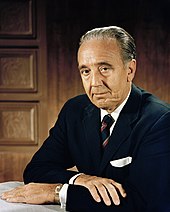
Dr. Kurt Debus, first director of KSC
Since KSC's germination, ten NASA officials have served as directors, including three former astronauts (Crippen, Bridges and Cabana):
| Proper noun | Kickoff | End | Reference |
|---|---|---|---|
| Dr. Kurt H. Debus | July 1962 | November 1974 | [79] |
| Lee R. Scherer | Jan 19, 1975 | September 2, 1979 | [80] |
| Richard Yard. Smith | September 26, 1979 | Baronial 2, 1986 | [81] |
| Forrest S. McCartney | August 31, 1987 | Dec 31, 1991 | [82] |
| Robert L. Crippen | January 1992 | January 1995 | [83] |
| Jay F. Honeycutt | Jan 1995 | March two, 1997 | [84] |
| Roy D. Bridges, Jr. | March 2, 1997 | August 9, 2003 | [85] |
| James Due west. Kennedy | August 9, 2003 | Jan 2007 | [86] |
| William Due west. Parsons | January 2007 | October 2008 | [87] |
| Robert D. Cabana | October 2008 | May 2021 | [88] |
| Janet E. Petro | June 2021 | Nowadays | [89] |
Labor force [edit]
When KSC separated from Marshall Infinite Flight Center in July 1962, it took 375 employees with it.
In May 1965, KSC had 7,000 employees and contractors move from rented infinite in Cocoa Beach to the new Merritt Isle facilities. The meridian number of persons working at the eye was 26,000 in 1968 (3,000 were civil servants). In 1970, President Nixon announced intent to reduce the toll of space operations and major cuts occurred at KSC. Past 1974, KSC's workforce was down to x,000 employees (2,408 ceremonious servants).[8]
A total of 13,100 people worked at the center every bit of 2011. Approximately 2,100 are employees of the federal authorities; the rest are contractors.[90] The average annual salary for an on-site worker in 2008 was $77,235.[91]
The end of the Space Shuttle program in 2011, preceded past the cancellation of Constellation Programme in 2010, produced a significant downsizing of the KSC workforce like to that experienced at the end of the Apollo program in 1972. As part of this downsizing, 6,000 contractors lost their jobs at the center during 2010 and 2011.[92]
In popular culture [edit]
In improver to beingness oftentimes featured in documentaries, Kennedy Space Center has been portrayed on moving picture many times. Some studio movies have even gained access and filmed scenes inside the gates of the infinite middle. If extras are needed in those scenes, space center employees are recruited (employees use personal time during filming). Films with scenes at KSC include:[93]
- Moonraker
- SpaceCamp
- Apollo thirteen
- Contact
- Armageddon [94]
- Space Cowboys
- Swades
- Transformers 3: Dark of the Moon
- Tomorrowland
- Sharknado iii: Oh Hell No!
- First Man
- Geostorm
- Men in Black three
Several television shows accept had KSC as one of the primary settings, though non necessarily with whatsoever scenes filmed on center:
- I Dream of Jeannie
- The Greatcoat
- The Astronaut Wives Social club
British-Irish band One Management likewise filmed their music video for "Elevate Me Down" at KSC.
Kennedy Space Center serves as the location of the final boxing nearly the end of Stone Ocean betwixt the Joestar Group and Enrico Pucci.[95]
Run into also [edit]
- Air Force Infinite and Missile Museum
- Astronaut beach house
- Launch Circuitous 34 – used for the smaller Apollo Saturn I and Saturn IB rockets
- Launch Complex 37 – used for the smaller Apollo Saturn I and Saturn IB rockets
- List of memorials to John F. Kennedy
- List of tallest buildings and structures in the world
- Mobile launcher platform
- NASA Causeway
- Solar eclipse of August 12, 2045 (Kennedy Infinite Eye volition be in the path of totality)
- Swamp Works
- Crawler-transporter
Notes [edit]
- ^ Number includes commercial tenants.
References [edit]
Citations [edit]
- ^ Kennedy Infinite Middle gets outset adult female managing director, Janet Petro, afterward Bob Cabana promoted to NASA.
- ^ a b 2021 Kennedy Space Eye Annual Report (PDF). NASA. 2021. pp. 50, 48. Retrieved February 3, 2022.
- ^ "Kennedy Business concern Report" (PDF). Almanac Report FY2010. NASA. February 2011. Retrieved August 22, 2011.
- ^ "Kennedy Space Center Implementing NASA'south Strategies" (PDF). NASA. 2000. Retrieved Nov 5, 2015.
- ^ "Appendix 10 – Government Organizations Supporting Project Mercury". NASA History Program Part. NASA. Retrieved November half dozen, 2015.
- ^ "2. Projection Support from the NASA Centers". Mercury Projection Summary (NASA SP-45). NASA. Retrieved Nov half-dozen, 2015.
- ^ "Mercury Mission Command". NASA. Retrieved Nov half dozen, 2015.
- ^ a b c d due east f 1000 h Lipartito, Kenneth; Butler, Orville (2007). 'A History of the Kennedy Space Center. University Press of Florida. ISBN978-0-8130-3069-ii.
- ^ a b "Research & Applied science". Kennedy Infinite Middle. NASA. March 3, 2015. Retrieved Nov five, 2015.
- ^ "NASA Partnerships Launch Multi-User Spaceport". NASA. May one, 2014. Retrieved November 5, 2015.
- ^ a b "Kennedy Creating New Master Plan". NASA. March 12, 2012. Retrieved November 5, 2015.
- ^ "Kennedy Space Centre Story". NASA. Retrieved May thirteen, 2019.
- ^ "History of Greatcoat Canaveral Chapter 3 | Spaceline". Retrieved May 27, 2021.
- ^ Charles D. Benson; William Barnaby Faherty. "Country, Lots of Country – Much of It Marshy". Moonport: A History of Apollo Launch Facilities and Operations. NASA. Retrieved August 27, 2009.
- ^ Muschamp, Herbert (Jan 28, 1999). "Charles Luckman, Builder Who Designed Penn Station'south Replacement, Dies at 89". The New York Times . Retrieved August 22, 2011.
- ^ a b "Kennedy History Quiz". NASA. Retrieved Nov v, 2015.
- ^ "The National Athenaeum, Lyndon B. Johnson Executive Order 11129". Retrieved Apr 26, 2010.
- ^ "Kennedy Space Center Story". NASA. 1991. Retrieved November 5, 2015.
- ^ Benson, Charles D.; Faherty, William B. (August 1977). "Chapter 7: The Launch Advisers Becomes an Operational Center – Kennedy's Last Visit". Moonport: A History of Apollo Launch Facilities and Operations. History Series. Vol. SP-4204. NASA. Archived from the original on November half-dozen, 2004.
- ^ "See All Attractions | Kennedy Space Centre". world wide web.kennedyspacecenter.com . Retrieved June five, 2020.
- ^ "Apollo xi Mission Overview". Apr 17, 2015.
- ^ Heppenheimer, T. A. (1998). The Space Shuttle Determination. NASA. pp. 425–427. Archived from the original on October xxx, 2004.
- ^ Shuttle Landing Facility (SLF). Science.ksc.nasa.gov. Retrieved on May 5, 2012.
- ^ "Way Guide for NASA History Authors and Editors". NASA's History Part. NASA. Retrieved November six, 2015.
- ^ "Presidential Directive on National Space Policy". NASA. White House. Feb xi, 1988. Retrieved Nov half dozen, 2015.
- ^ a b "Kennedy Space Center Payload Processing". NASA. March ii, 2015. Retrieved November 5, 2015.
- ^ "Kennedy Space Center". NASA. March 27, 2015. Retrieved Nov five, 2015.
- ^ "Commercial Coiffure Programme". NASA. March 31, 2015. Retrieved November 5, 2015.
- ^ "Exploration Ground Systems". NASA. March 3, 2015. Retrieved Oct xiii, 2018.
- ^ Garcia, Mark (April 12, 2015). "Orion Overview". NASA . Retrieved January 17, 2017.
- ^ "Orion Explained: NASA's Multi-Purpose Crew Vehicle (Infographic)". Space.com . Retrieved January 17, 2017.
- ^ "Launching Rockets". NASA. April 2015. Retrieved November v, 2015.
- ^ "Pocket-size Satellite Missions". NASA. April 13, 2015. Retrieved Nov five, 2015.
- ^ "Military camp Kennedy Space Center and Space Camp". NASA. Apr 28, 2015. Retrieved September 18, 2019.
- ^ "Hangar Due south History". Kennedy Infinite Center. NASA. May 18, 2015. Retrieved November five, 2015.
- ^ "iv. Kennedy Space Center Planning and Development Office – What Nosotros Offering – Physical Avails". Archived from the original on April 4, 2014. Retrieved March 4, 2014.
- ^ "Kennedy Space Center Resource Encyclopedia". NASA – Kennedy Space Center. 2010. Retrieved March 4, 2014.
- ^ Headquarters Building (HQ). Science.ksc.nasa.gov. Retrieved on May 5, 2012.
- ^ a b Borchert, Carol Ann; Arthur, Michael A. (2007). Ginanni, Katy (ed.). "John F. Kennedy Space Center Library". Serials Review. 33 (4): 277–280. doi:10.1016/j.serrev.2007.08.012 – via Academia.edu.
- ^ "Kennedy Space Center Primal Campus". NASA. March 25, 2015. Retrieved February 3, 2016.
- ^ "Fundamental Campus of the Kennedy Space Eye" (PDF). Kennedy Space Center Fact Sheets. NASA. Retrieved February 3, 2016.
- ^ "Media Invited to Groundbreaking for New Kennedy Space Center Headquarters". NASA. October 2, 2014. Retrieved November 5, 2015.
- ^ "The NASA Railroad" (PDF). Kennedy Space Center Fact Sheets. NASA. Retrieved February 3, 2016.
- ^ Dean, James (May 24, 2015). "NASA Railroad rides into sunset". Florida Today. Melbourne, Florida. p. 25A. Retrieved June 2, 2015.
- ^ "Operations and Checkout Building".
- ^ Mansfield, Cheryl 50. (July xv, 2008). "Catching a Ride to Destiny". NASA. Retrieved July thirteen, 2009.
- ^ Space Station Processing Facility (SSPF). Science.ksc.nasa.gov. Retrieved on May 5, 2012.
- ^ Vertical Processing Facility. Scientific discipline.ksc.nasa.gov. Retrieved on May v, 2012.
- ^ "Hypergolic Maintenance and Checkout Facility".
- ^ Granath, Bob (August 25, 2016). "Multi-Payload Processing Facility Provides 'Gas Station' for Orion". NASA . Retrieved December 1, 2019.
- ^ "Payload Hazardous Servicing Facility". Scientific discipline.ksc.nasa.gov. Retrieved May two, 2018.
- ^ Bergin, Chris; Munson, Noel (March 29, 2017). "Bluish Origin working towards making the Greatcoat its Orbital Launch Site". NASASpaceFlight . Retrieved January 20, 2018.
- ^ Benson, Charles D.; Faherty, William B. (Baronial 1977). "Preface". Moonport: A History of Apollo Launch Facilities and Operations. History Serial. Vol. SP-4204. NASA.
- ^ "Senate". Congressional Record: 17598. September 8, 2004.
- ^ Kelly, Emre (June xiv, 2019). "Run across Launch Complex 48, NASA's new minor rocket pad at Kennedy Space Center". Florida Today . Retrieved January 7, 2020.
- ^ Draft Environmental Cess for Launch Complex 48 (PDF). NASA. February nineteen, 2019. pp. ii–iii. Retrieved Jan 7, 2020.
- ^ "Partnering with KSC". Archived from the original on November iv, 2015.
- ^ "The Forepart Page Annal". Doing Business With Kennedy. NASA. March 26, 2015. Retrieved Nov 5, 2015.
- ^ "Partnering with KSC".
- ^ "Solar Energy Centers". FPL.
- ^ "Space Declension Adjacent Generation Solar Energy Center". Sustainability. NASA. June 7, 2013. Retrieved Nov 5, 2015.
- ^ "Partnering with KSC".
- ^ Stratford, Amanda (Jan 12, 2010). "NASA's new prototype". Florida Today. Melbourne, Florida: Florida Today. pp. 1A.
- ^ Dean, James. "KSC Visitor Complex introduces 'Heroes and Legends'". Florida Today . Retrieved August six, 2015.
- ^ "Iconic KSC countdown clock gets a new home". News 13. March i, 2016. Retrieved March 2, 2016.
- ^ "Honoring Apollo 10 | Apollo Program 50th Anniversary Celebrations". Archived from the original on April 8, 2019.
- ^ a b "Historic Properties at Kennedy Space Center Every bit of Jan 2015" (PDF). Environmental Planning – Cultural Resources. NASA. Archived from the original (PDF) on March iii, 2016. Retrieved November v, 2015.
- ^ "Understanding NASA's Historic Districts" (PDF). Environmental Program at KSC. NASA. June 2008. Archived from the original (PDF) on Nov 17, 2015. Retrieved November v, 2015.
- ^ "Environmental Planning – Cultural Resources". Ecology Programme at KSC. NASA. Archived from the original on September 22, 2015. Retrieved November v, 2015.
- ^ "NASA's Celebrated Preservation Program: Jubilant and Managing Significant Celebrated Resources" (PDF). NASA. Archived from the original (PDF) on Nov 17, 2015. Retrieved November five, 2015.
- ^ "NASAfacts: Rotation, Processing and Surge Facility (RPSF) at Kennedy Space Center" (PDF). NASA. Retrieved December 21, 2019.
- ^ Oliver, John E. (2005). Encyclopedia of world climatology. Springer. p. 452. ISBN978-1-4020-3264-6.
- ^ "Lightning: FAQ". UCAR Communications. University Corporation for Atmospheric Research. Archived from the original on March 16, 2010. Retrieved June 17, 2010.
- ^ KSC – Lightning and the Space Plan Archived September 24, 2008, at the Wayback Machine Retrieved May 28, 2008
- ^ "NASA Checks Shuttle Later Lightning Strike Virtually Launch Pad". Space.com . Retrieved October xix, 2017.
- ^ "NASA Assesses Hurricane Frances Damage". NASA Printing Release.
- ^ Horn-Muller, Ayurella; Joy, Rachael (November fourteen, 2019). "Could Kennedy Space Center launch pads exist at risk every bit climate changes? Experts say yes". Climate Central / Florida Today . Retrieved December eleven, 2019.
- ^ "Time to come Flood Adventure: John F. Kennedy Space Eye & Greatcoat Canaveral Air Strength Station" (PDF). Climate Central. Oct 2019. Retrieved December 11, 2019.
- ^ NASA – Biography of Dr. Kurt H. Debus. Nasa.gov. Retrieved on May 5, 2012.
- ^ NASA – Biography of Lee R. Scherer. Nasa.gov. Retrieved on May v, 2012.
- ^ NASA – Biography of Richard G. Smith. Nasa.gov. Retrieved on May 5, 2012.
- ^ NASA – Biography of Forrest Southward. McCartney. Nasa.gov. Retrieved on May 5, 2012.
- ^ NASA – Biography of Robert L. Crippen. Nasa.gov. Retrieved on May 5, 2012.
- ^ NASA – Biography of Jay F. Honeycutt. Nasa.gov. Retrieved on May 5, 2012.
- ^ NASA – Biography of Roy Bridges. Nasa.gov. Retrieved on May 5, 2012.
- ^ NASA – NASA KSC Director Announces Retirement. Nasa.gov (February 24, 2008). Retrieved on May five, 2012.
- ^ NASA – Biography of William W. (Bill) Parsons. Nasa.gov (February 24, 2008). Retrieved on May 5, 2012.
- ^ "Cabana to Succeed Parsons as Kennedy Space Center Manager" (Press release). NASA. September 30, 2008. Retrieved September thirty, 2008.
- ^ Kennedy Infinite Center gets commencement woman director, Janet Petro, after Bob Cabana promoted to NASA, Orlando Spotter, June 30, 2021, retrieved July 1, 2021
- ^ Dean, James (March 17, 2011). "NASA budget woes leads to layoffs". Federal Times . Retrieved August 21, 2011.
- ^ Peterson, Patrick (November 28, 2010). "High-paying jobs scant outside KSC". Melbourne, Florida: Florida Today. pp. 1A.
- ^ Dean, James (November 5, 2011). "Laid-off KSC workers' supplies eagerly accepted by educators". Florida Today. Melbourne, Florida. pp. 2B.
- ^ Sangalang, Jennifer (January 19, 2018). "Hey, daughter: Casting call for Ryan Gosling movie 'First Homo' at Kennedy Space Heart". Florida Today. U.s.a. Today Network. Retrieved January 30, 2018.
- ^ "Armageddon Product Notes". Michael Bay. October 4, 2012. Retrieved Jan 30, 2018.
- ^ Araki, Hirohiko (April four, 2003). JoJo's Bizarre Hazard: Stone Body of water. Shueisha. ISBN978-four-08-873410-1.
Sources [edit]
- Benson, Charles Due west.; Faherty, William Barnaby (1978). Moonport: A History of Apollo Launch Facilities and Operations. Scientific and Technical Information Part, NASA. Archived from the original on November 17, 2004. .
- Middleton, Sallie. "Infinite Rush: Local Bear upon of Federal Aerospace Programs on Brevard and Surrounding Counties," Florida Historical Quarterly, Fall 2008, Vol. 87 Effect 2, pp. 258–289.
- Reynolds, David West (September 2006). Kennedy Space Center: Gateway to Space. Buffalo, NY: Firefly Books. ISBN978-1-55407-039-eight . Retrieved January 30, 2010.
-
 This commodity incorporates public domain material from websites or documents of the National Aeronautics and Space Administration.
This commodity incorporates public domain material from websites or documents of the National Aeronautics and Space Administration.
External links [edit]
- Kennedy Infinite Center Web site
- Kennedy History Vault
- Spaceport News KSC Employee Mag
- KSC Visitor Complex Spider web site
- Streaming audio of KSC radio communications
- Astronauts Memorial Foundation Web site
- "America's Space Program: Exploring a New Frontier", a National Park Service Education with Historic Places lesson plan
- "Aviation: From Sand Dunes to Sonic Booms", a National Park Service Detect Our Shared Heritage travel itinerary
- A Field Guide to American Spacecraft
- Documentary of the U.Due south. Space Plan in Florida
Source: https://en.wikipedia.org/wiki/Kennedy_Space_Center






0 Response to "The Best Nasa Space House in the Usa"
Post a Comment